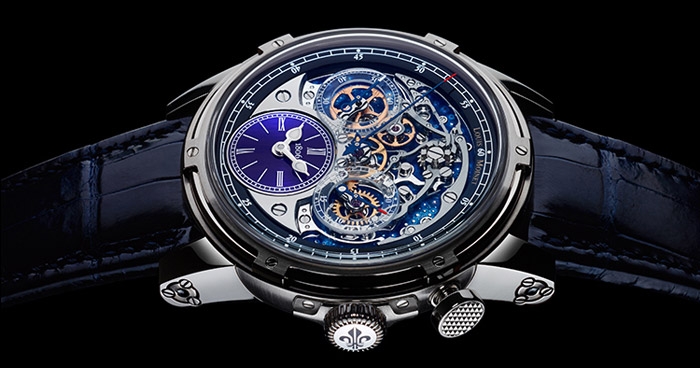Louis Moinet’s intriguing 2016 collection

Louis Moinet’s 2016 collection celebrates the bicentenary of the invention of the chronograph by the watchmaking genius in 1816 and the tenth anniversary of its rebirth by unveiling extraordinary showstoppers that capture the mind and the heart. Earlier limited editions don new ensembles and enthral watch aficionados
Ateliers Louis Moinet – so named in honour of the legendary watchmaker Louis Moinet whose creations graced royal personages in their time and palaces and museums in the present day – lives up to its ethos, creating works of mechanical art in limited editions for the leaders of today.
Louis Moinet is based at Saint-Blaise near Neuchâtel in the heart of Switzerland’s watchmaking area and is an independent company established about 15 years ago by Jean-Marie Schaller with the aim of producing watches in the spirit of Louis Moinet: a blend of art and technology.
One way in which the brand ensures innovation and exclusivity is through the creation of masterpieces of time that utilise rare materials. Witness the marque’s use of fragments from meteorites of Mars, Moon and Mercury, while the Geograph Rainforest chronograph, which won the “Best of the Best” Red Dot Design Award, had two chronograph counters made from genuine petrified palm wood. This emblematic tree, believed to be 70 million years old, comes from the tropical forests of South-East Asia.
Their Treasures Of The World collection showcased some of the rarest and least-known hardstones such as labradorite, petrified sequoia, hawk’s eye or green aventurine. The show-stealer was the red stromalite – the world’s oldest known fossil, dating back 3.5 billion years and originating from Australia – which was fashioned into the dial of a tourbillon.
Memoris Anniversaire White Gold
The company, which aims to “restore Louis Moinet to his rightful place at the top of the watchmaking pantheon,” celebrates its legendary namesake by lighting up the stars in its new offering – the Memoris Anniversaire. The first chronograph-watch clothed with light, the Anniversaire is a limited edition watch that marks the start of a series of commemorative pieces dedicated to the bicentenary of the invention of the chronograph in 1816.
Striking features that characterise the Memoris are the new hour dial – made in enamel for the first time in history; a new mainplate, painted and decorated with star constellations; and a new translucent flange and counter bridge.

The Memoris Anniversaire uses a unique fixed graver engraving technique for its starry back, which consists of a brass plate coated in a translucent blue, where the stars have been created using the new process. Each star is worked on individually, thus resulting in a never-before-seen portrait of a starry sky with a very natural sparkle. Devised by one of Louis Moinet’s craftsmen, this involves attaching a specially made lathe to a traditional rose engine (also known as a guillocheuse).
The individual stars are all fashioned to feature different angles and depths, so that each and every one captures as much light as possible and the end result gives the novel impression that certain stars really are shining. For the flange and counter bridge, Ateliers Louis Moinet has used a revolutionary translucent material that is through-coloured and yet maintains a certain degree of transparency.
Louis Moinet has redeveloped practically every decorative item of the watch – the case, hands, dial, oscillating weight, folding clasp, and more – with a new use for gemstones. Black zircon, in a screwed setting, has been used decoratively on the case horns.
The final result is the Memoris: a 46 mm timepiece in white gold, in a limited edition of just 20 pieces. Embodying the essence of true commemoration, it links Louis Moinet’s heritage with the creative vision of the Ateliers that today honour his memory.
Memoris Anniversaire Rose Gold
The Memoris Anniversaire Rose Gold edition is housed in a 46 mm rose gold case, whose 52 parts are held together by six visible, functional screws on the bezel. Especially created for Memoris, the case sports alternating brushed and polished finishes and bears the Louis Moinet signature on the side. In homage to the watchmaking skills of our forebears, it features chevé concave crystals, now made from scratchproof sapphire.
Within the case sits the chronograph – moved to the fore, on the dial side. When the pusher is depressed, all of the chronograph’s actions can be admired. To ensure no part of the chronograph mechanism is obscured, the counters are made from a specially manufactured translucent material.
The innovative movement, meanwhile, is neither a skeleton nor a supplementary module: rather, it has been designed for and around the chronograph. Louis Moinet has opted to place the time mechanism on the back of the automatic movement, beneath the plate.
Black Gold Derrick
Louis Moinet’s latest offering, the Black Gold Derrick, straddles the worlds of oil and watchmaking resulting in a spectacular creation.
Three years after it was first created, with a few dozen watches’ worth of original limited editions, the Derrick Tourbillon has taken a new turn, picking up the watchmaking tale where it left off with the advent of the Black Gold Derrick, with the openwork mechanical parts of the movement further enhancing the technology involved in its extraordinary mechanism. The piece boasts a skeleton movement, haute horlogerie finishings, a three-day power reserve, and a new seconds display.
The original spirit of the piece, redolent of the world of oil, remains intact. The watch’s entire movement represents the drilling process. A drive shaft sits on the right of the dial, between 2 o’clock and 4 o’clock. This powers a long articulated arm, known as the walking beam, between 10 o’clock and 2 o’clock. At its left-hand end is the oblong-shaped ‘head’, which is the most striking visual characteristic of a derrick.
The circuit naturally ends with a barrel at 9 o’clock, made from titanium and symbolising successful extraction. It too is in constant rotation: Louis Moinet has dedicated it to marking the seconds, read off at the bottom of the barrel, on a red engraved seconds track. The rotating barrel is also engraved with Louis Moinet’s name, atop its iconic fleur-de-lis motif.
Echoing the black gold, which is depicted as running through the watch, the bridges are made from black PVD. Created exclusively for the Black Gold Derrick, they are open-worked, so as to give pride of place to the visual effect of the moving train. The plate is also completely new, as is the barrel cover. This now offers a view of the spring from above, while raised engraving on the minimalist-style cover proudly displays the 72-hour power reserve.
The Black Gold Derrick is imbued with the spirit of fine watchmaking. The time is displayed by two central rhodium-plated hands, regulated by a tourbillon escapement at 6 o’clock. The bridges and their many acute angles are all hand-finished, featuring pearled decor on the plate and the derrick bridge, and fine lines on the other bridges.
The assembly is housed in a new white gold case by Louis Moinet dubbed NEO. Premiered worldwide at Baselworld, it embodies a noteworthy step by the Ateliers towards a more dynamic, contemporary style. The NEO case’s original, contemporary design includes open-work lugs; in a fine watchmaking flourish, these sport black zircon tips. In addition to open-work lugs, the sides have been sculpted and the crown has also been modernised. This technical assembly, with over 45 parts, is topped by a six-screw bezel, now one of Louis Moinet’s stylistic hallmarks.
The Black Gold Derrick comes in a strictly limited edition of 28 pieces.
Sideralis: an interstellar inverted double tourbillon that moves planets physically present in the watch
The maison describes the Sideralis as an invitation to embark on an interstellar journey, a whole new kind of discovery that’s singularly technical and poetic.

The timepiece in question defies comparison, simply because to date, Sideralis does not have any equivalent anywhere in the world of watchmaking and is protected by two patent applications. Sideralis makes an unequivocal statement that Louis Moinet is perhaps the last fully independent firm to be investing in new components with the sole aim of inspiring awe among lovers of fine watches.
Sideralis is structured around two especially extraordinary tourbillons with three special features: Both of the tourbillons are oversized, with cages measuring 14.9 mm – half as big again as the average. Another is that this is the largest assembly of two tourbillons ever to have existed. The two tourbillons are designed to be physically above the movement – above the dial, even. The two raised cages are large as life and wholly visible, revealing balance wheels with beautifully styled screws – and an absolutely incomparable aesthetic appearance. The third interesting fact is that the tourbillons rotate in opposite directions and not just for stylistic reasons; the counter-rotation provides the motive power required for the star mechanism – the Sideralis complication.
Now, tourbillons move the planets in the Sideralis. Forthe first time ever, a complication is driven by a double tourbillon: a time dial situated at 12 o’clock, comprising two discs, one atop the other. The top one features a tiny hand-painted picture. This hand-crafted marvel depicts the universe and its constellations of stars and planets, painted one by one on a dark blue sidereal background. The animation completes one counter-clockwise rotation every 60 seconds.
On this upper disc there is a circular opening at 12 o’clock, through which can be glimpsed the three planets painted on the lower disc, seen to be rotating in the opposite direction at the same speed. Through the opening, the lower disc reveals the planet Mars, the Moon, and Mercury in succession. This feature represents a wholly new conceptual and artistic approach in which these astral bodies are physically present.
These three bodies were not chosen at random. Each of the micro-paintings includes genuine dust from the heavenly body in question: a fragment of Mars, moon dust, and extremely rare fragments of the Rosetta Stone, whose scientific name is Sahara 99555. The Rosetta Stone is believed to have travelled across the universe to reach us: it’s the oldest known to mankind, believed by the scientific community to have come from Mercury and to be four-and-a-half-billion years old. Fragments of meteorites from Mars, the Moon and Sahara 99555 also appear on the lower disc, positioned between the planets, floating in the cosmos, or included in a hand-painted shooting star.
The inverted double tourbillon, powering an exclusive complication, is an unprecedented innovation, with two patents pending to protect it. The Sideralis caliber is also fully exclusive to Louis Moinet, mounted on a hand-painted aventurine dial that matches the universe depicted on the time disc. Sideralis comes in a 47.4 mm grey gold case – and in a limited edition of just 28 watches.
20-Second Tempograph Deep Blue
Blue – a predominant colour in watchmaking ever since the first hands on timepieces emerged – is now to be found for the first time on Louis Moinet’s 20-Second Tempograph.
Sometimes, the detail of one mechanism changes the whole feel of a piece: decked in blue, the dynamic and contemporary spirit of Louis Moinet’s 20-Second Tempograph really comes to the fore, mirroring the spirit of watchmaker Louis Moinet’s timepieces.

The watch is by no means blue all over, though. On the dial, blue has been used, sparingly, just on the time-telling components: the seconds hand at 9 o’clock, the legendary 20-second retrograde mechanism between 1 o’clock and 2 o’clock, and the hour dial. On the back, the oscillating weight also offers up its guilloché design to receive this new, deep blue décor, resulting in a scintillating interplay of shapes and hues.
The new Deep Blue 20-Second Tempograph comes in a limited edition of 60 pieces and will be unveiled as an exclusive feature at the Dubai Watch Week.




